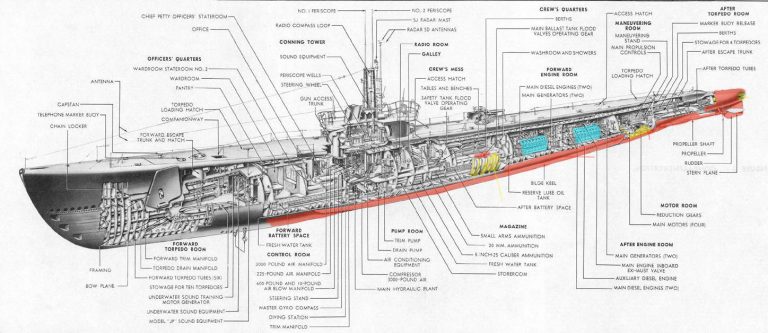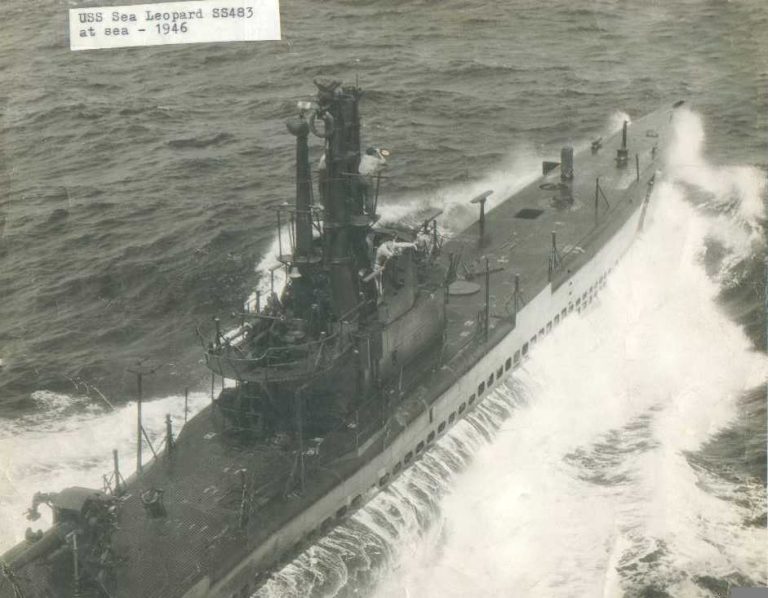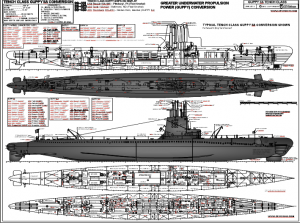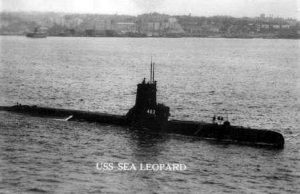|
|
Specificationsand Mods |
|
Specifications (as built) 1944 
| CLASS: TENCH diesel-electric | PROPULSION: | COMPLEMENT: |
| DISPLACEMENT: | 4 × Fairbanks-Morse Model 38D8-⅛ | 10 Officers/71 enlisted |
| Surfaced: 1,570 t. | driving electric generators | RANGE: |
| Submerged: 2,414 t. | 10 cylinder piston diesel engines | 11,000 miles, surfaced @ 10 knots |
| LENGTH: 311’8″ | 2 × 126-cell Sargo batteries | ENDURANCE: |
| BEAM: 27’4″ | 2 × low-speed direct-drive | 48 hours @ 2 knots submerged |
| DRAFT: 17’ | Elliott electric motors | 75 days on patrol |
| SPEED: | 2 propellers | ARMAMENT: |
| Surfaced: 20.25 k. | 5,400 shp (4.0 MW) surfaced | 10 21″ torpedo, 28 torpedoes |
| Submerged: 8.75 k. | 2,740 shp (2.0 MW) submerged | 1 5″ deck gun; Bofors 40 mm |
| TEST DEPTH: 400’ | 1 Oerlikon 20 mm cannon |
GUPPY II program 1949
The Sea Leopard had an SV radar and needed extra room to house the aerial, thus had a bulge at the sail top. Later modifications put the SS2 radar on that had a smaller aerial and had an indicator with interlocks, allowing the mast to be housed only with the aerial in certain angular positions.All boats converted during the GUPPY II program that originally had high-speed drive motors with reduction gears had these replaced with low-speed direct-drive motors, producing 2500 horsepower (1.9 MW) per shaft. GUPPY IIA program Implemented from 1952 to 1954 the GUPPY IIA, however, further alleviated the cramped internal conditions of earlier conversions by removing one forward engine and replacing it with pumps and air conditioning machinery. Some boats had the high-pressure air compressors relocated to the lower level of the forward engine room. The freezer and refrigerator units were moved to the space under the galley, and the sonar room was relocated to the forward end of the pump room. Sargo II batteries were installed in the existing battery wells.Externally, the GUPPY IIA differed from the GUPPY II and IA by having only three diesel exhaust outlets, whereas the earlier conversions had four.  Also, the sail was extended higher above the waterline, the “Northern Sail”, to raise the bridge, allowing it to be manned in more severe weather.
Also, the sail was extended higher above the waterline, the “Northern Sail”, to raise the bridge, allowing it to be manned in more severe weather.
This page was last reviewed/modified on April 2. 2017.
If you have any suggestions, submissions, or corrections, contact the Sea Leopard Webmaster




